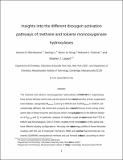| dc.contributor.author | Bochevarov, Arteum D. | |
| dc.contributor.author | Li, Jianing | |
| dc.contributor.author | Song, Woon Ju | |
| dc.contributor.author | Friesner, Richard A. | |
| dc.contributor.author | Lippard, Stephen J. | |
| dc.date.accessioned | 2012-07-17T12:56:38Z | |
| dc.date.available | 2012-07-17T12:56:38Z | |
| dc.date.issued | 2010-11 | |
| dc.date.submitted | 2011-04 | |
| dc.identifier.issn | 0002-7863 | |
| dc.identifier.issn | 1520-5126 | |
| dc.identifier.uri | http://hdl.handle.net/1721.1/71643 | |
| dc.description.abstract | The methane and toluene monooxygenase hydroxylases (MMOH and TMOH, respectively) have almost identical active sites, yet the physical and chemical properties of their oxygenated intermediates, designated P*, H[subscript peroxo], Q, and Q* in MMOH and ToMOH[subscript peroxo] in a subclass of TMOH, ToMOH, are substantially different. We review and compare the structural differences in the vicinity of the active sites of these enzymes and discuss which changes could give rise to the different behavior of H[subscript peroxo] and Q. In particular, analysis of multiple crystal structures reveals that T213 in MMOH and the analogous T201 in TMOH, located in the immediate vicinity of the active site, have different rotatory configurations. We study the rotational energy profiles of these threonine residues with the use of molecular mechanics (MM) and quantum mechanics/molecular mechanics (QM/MM) computational methods and put forward a hypothesis according to which T213 and T201 play an important role in the formation of different types of peroxodiiron(III) species in MMOH and ToMOH. The hypothesis is indirectly supported by the QM/MM calculations of the peroxodiiron(III) models of ToMOH and the theoretically computed Mössbauer spectra. It also helps explain the formation of two distinct peroxodiiron(III) species in the T201S mutant of ToMOH. Additionally, a role for the ToMOD regulatory protein, which is essential for intermediate formation and protein functioning in the ToMO system, is advanced. We find that the low quadrupole splitting parameter in the Mössbauer spectrum observed for a ToMOHperoxo intermediate can be explained by protonation of the peroxo moiety, possibly stabilized by the T201 residue. Finally, similarities between the oxygen activation mechanisms of the monooxygenases and cytochrome P450 are discussed. | en_US |
| dc.description.sponsorship | National Institute of General Medical Sciences (U.S.) (grant no.GM032134) | en_US |
| dc.language.iso | en_US | |
| dc.publisher | American Chemical Society (ACS) | en_US |
| dc.relation.isversionof | http://dx.doi.org/10.1021/ja110287y | en_US |
| dc.rights | Article is made available in accordance with the publisher's policy and may be subject to US copyright law. Please refer to the publisher's site for terms of use. | en_US |
| dc.source | Prof. Lippard via Erja Kajosalo | en_US |
| dc.title | Insights into the different dioxygen activation pathways of methane and toluene monooxygenase hydroxylases | en_US |
| dc.type | Article | en_US |
| dc.identifier.citation | Bochevarov, Arteum D. et al. “Insights into the Different Dioxygen Activation Pathways of Methane and Toluene Monooxygenase Hydroxylases.” Journal of the American Chemical Society 133.19 (2011):7384–7397. | en_US |
| dc.contributor.department | Massachusetts Institute of Technology. Department of Chemistry | en_US |
| dc.contributor.approver | Lippard, Stephen J. | |
| dc.contributor.mitauthor | Song, Woon Ju | |
| dc.contributor.mitauthor | Lippard, Stephen J. | |
| dc.relation.journal | Journal of the American Chemical Society | en_US |
| dc.eprint.version | Author's final manuscript | en_US |
| dc.type.uri | http://purl.org/eprint/type/JournalArticle | en_US |
| eprint.status | http://purl.org/eprint/status/PeerReviewed | en_US |
| dspace.orderedauthors | Bochevarov, Arteum D.; Li, Jianing; Song, Woon Ju; Friesner, Richard A.; Lippard, Stephen J. | en |
| dc.identifier.orcid | https://orcid.org/0000-0002-2693-4982 | |
| mit.license | PUBLISHER_POLICY | en_US |
| mit.metadata.status | Complete | |
